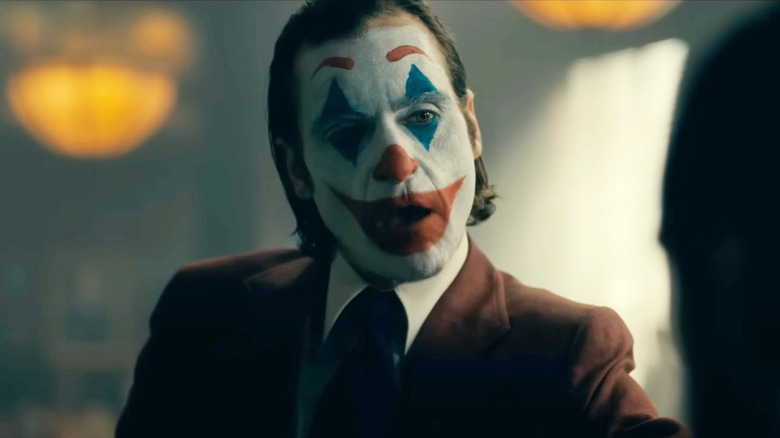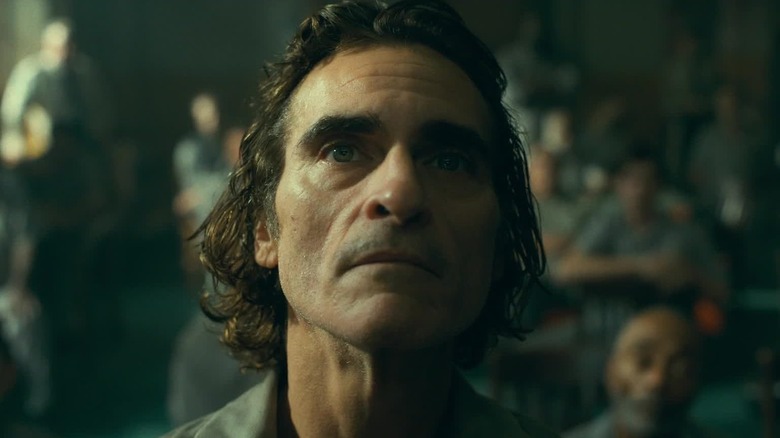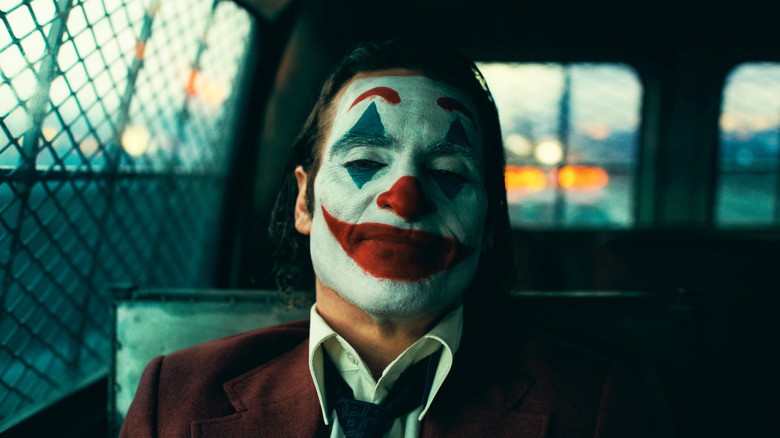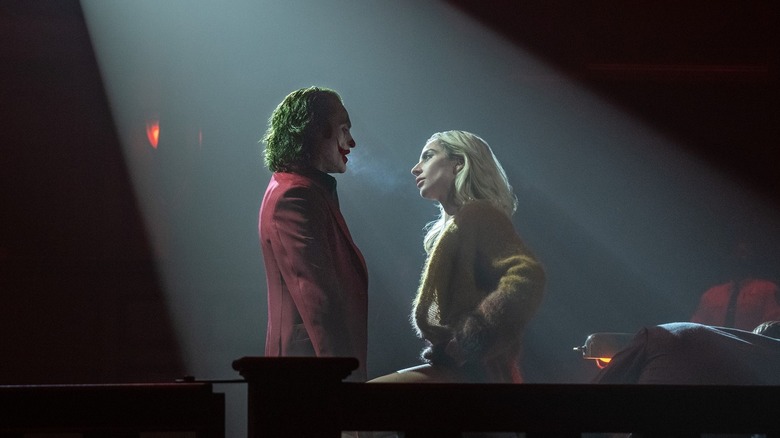Joker 2's Most Controversial Moments Explained By Director Todd Phillips
This article contains spoilers for "Joker: Folie à Deux."
In the 2015 comic book series "Justice League: Darkseid War," Batman comes across a mystical high-tech throne called the Mobius Chair, ordinarily operated by a character called Metron and powered by a mysterious substance called Element X. Never mind how, but when Metron is pulled out of the chair, it begins to go a little haywire, lacking an occupant. Batman, acting quickly, sits in the chair to calm it down. It seems, however, that the chair forces new, mystical energies into Batman's body and his brain suddenly has the answers to everything in the universe.
Testing it, Batman asks the chair who killed his parents. The chair, after all, would know all about his secret identity. The chair says Joe Chill, which is correct. Batman then asks the chair the real name of the Joker. The answer: there's more than one Joker. Yes, it seems that all this time, Batman has not been fighting a single nemesis, but three different men all dressed as evil criminal clowns. Batman — and the readers — are shaken by the news.
The concept was explored further in the 2020 comic "Batman: Three Jokers," which noted that the criminal Joker from the 1930s was different from the literal clown who murdered Jason Todd/Robin, and they were both different from the twisted criminal in "The Killing Joke." The actual canon of "The Three Jokers" can, however, be debated.
This concept is vital to remember when thinking about Todd Phillips' films "Joker" (2019) and "Joker: Folie à Deux" (2024). In those movies, a man named Arthur Fleck (Joaquin Phoenix), about 35, slowly becomes the Joker after suffering from a lack of mental health support and attention in general. Bruce Wayne, meanwhile, is a young boy in the timeline of the film, causing some Batman fans to ask if the Joker will be rounding 60 or even 70 by the time the hero and the villain inevitably face off.
Speaking with IGN, Phillips offered a solution to any continuity issues fans may have: Arthur Fleck is never referred to as "The Joker," but instead may merely be "a Joker." Clever.
He's not The Joker, but he is A Joker
Comic book fans, to remind the reader, love canon. They like to construct a solid, vast, interconnected universe wherein a Batman story may, in an oblique way, connect to, say, a Green Lantern story or a Wonder Woman story. The interconnectivity of superhero universes has long been a feature of the medium, and it wasn't until the launching of the Marvel Cinematic Universe in 2008 that interconnected comic book lore became the central pivot point for a series of movies. Since then, superhero fans have made a point of taking notes and connecting the dots, looking for the ways small events in one film will introduce larger events in another. And, of course, the climax of the film series will arrive when all the characters from disparate chapters come together to shake hands and murder bad guys.
That thinking, however, doesn't apply to Phillips' two "Joker" movies. The films may, he noted, take place in the same universe as Batman, but the Arthur Fleck character is definitely not the same Joker that the hero will grow up to fight. This, Phillips said, was by design:
"One of the things that people never understood about the first movie was, 'I don't get it. He visits Bruce Wayne ... and he's 30 years older than Bruce Wayne. What kind of geriatric Joker is going to fight in the future?' [...] The first film is called 'Joker.' It's not called 'The Joker,' it's called 'Joker.' And the first film [was] 'An origin story.' Never said 'THE origin story.' It was this idea that maybe this isn't THE Joker. Maybe this is the inspiration for the Joker."
Phillips said that the audience was meant to look behind Arthur Fleck at all times and ponder if one of the strangers in the background was the kid who would be inspired to become Batman's Joker by him.
The many Jokers
This approach makes perfect sense. In the 2019 "Joker" film, Arthur, despite being a mentally unbalanced loner, managed to gain the attention of the media. He would rant about being treated unfairly and about being neglected, slowly coming to loathe the city and the people in it. His words inspired hundreds of nascent anarchists in Gotham City to also don clown masks and cause their own mischief. Without trying, Arthur Fleck became the figurehead of a criminal movement, inspiring people to take matters into their own hands, ignore the law, and cause chaos.
Eventually, Arthur appeared on a late-night talk show, where he murdered the host (Robert De Niro) in front of the cameras. That act, most assuredly, inspired many. In "Joker: Folie à Deux," a fellow inmate named Lee (Lady Gaga) says that she was inspired by a crappy TV movie based on the Joker's crimes. New acolytes are springing up, even if Arthur doesn't notice. Phillips, it seems, didn't want to reconcile the Joker as a mentally unwell killer and the Joker as a prince of crime. Arthur, he feels, is no leader:
"The big thing with Arthur [...] he's not a criminal mastermind. It's one of the things we've always said about him, even in the first movie. And if we never made a sequel, it was just like, think what you want about what this guy turns into, but it's never any version of the Joker that we all grew up on. You know what I mean? That's just not who Arthur is. So, it's kind of this idea of when somebody becomes an icon, and we put things on that person as a group, as a society, as a media, as whatever. We put things on that person that maybe they can't live up to."
Indeed, Arthur can't live up to it and eventually rejects the label.
The dance is over
"Folie à Deux" ends on a few dour, depressing notes. The film — extraordinarily long — spends the bulk of its running time in court, literally re-litigating the events of the first film. Arthur Fleck's lawyer (Catherine Keener) is trying to mount an insanity defense, arguing that Arthur suffered from a split personality. The Joker, she tries to prove, was technically a different person from Arthur. Because Arthur is so passive, he goes along with it. Lee, however, convinces him that he needs to be more public and open about his chaos-loving Joker instincts, and she is all too willing to become his co-creator of chaos. She is never called "Harley Quinn," however.
At the end of the film, however, Arthur realizes there's nothing to be gained from continuing his Joker ideas. Everyone else's ideas of whom the Joker is and what he represents is never agreed upon by the media, by Lee, or by the courts. Eventually, Arthur merely breaks down and says, out loud, that there is no Joker. "Folie à Deux" condemns its own comic book lore, stating that heroes and villains are futile, as all they create are disagreements and arguments. Phillips described the ending thusly:
"What he realizes is basically you can't fight City Hall. Meaning, when you're Arthur you're going to always lose, and corruption will always win. Whether it's the corruption of the prison system/guards, the corruption of the judicial system, the corruption of the media, and the way they represent Arthur in that sort of Tom Snyder-esque interview in the beginning with the very brilliant Steve Coogan. The only way to win is to burn it all down in Arthur's head, like just a little 'F*** it all.' You know what I mean? Because you just can't win when you're a person like Arthur."
And, naturally, he loses. His death may lead to a new Joker in the future, but for now, we're asked to look at the sad moment when a loser lost.
"Joker: Folie à Deux" is now playing in theaters.



